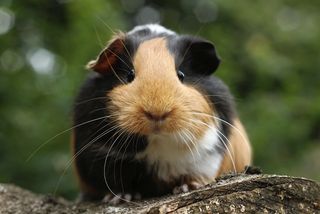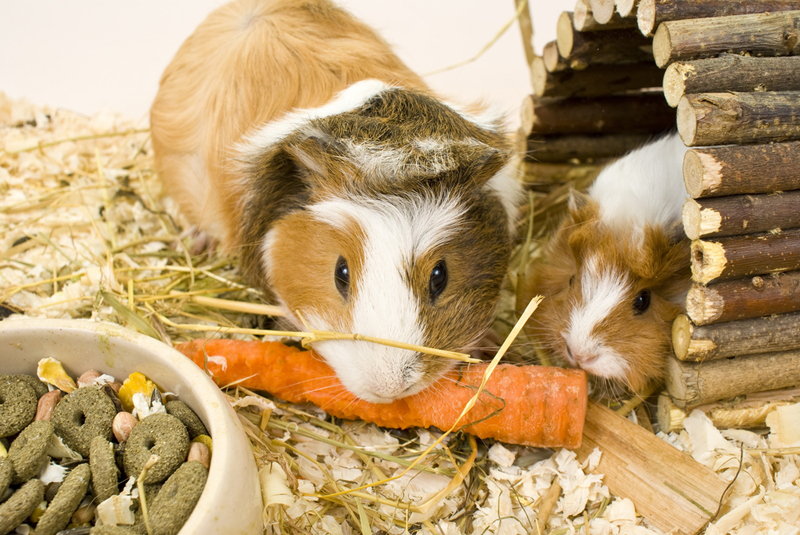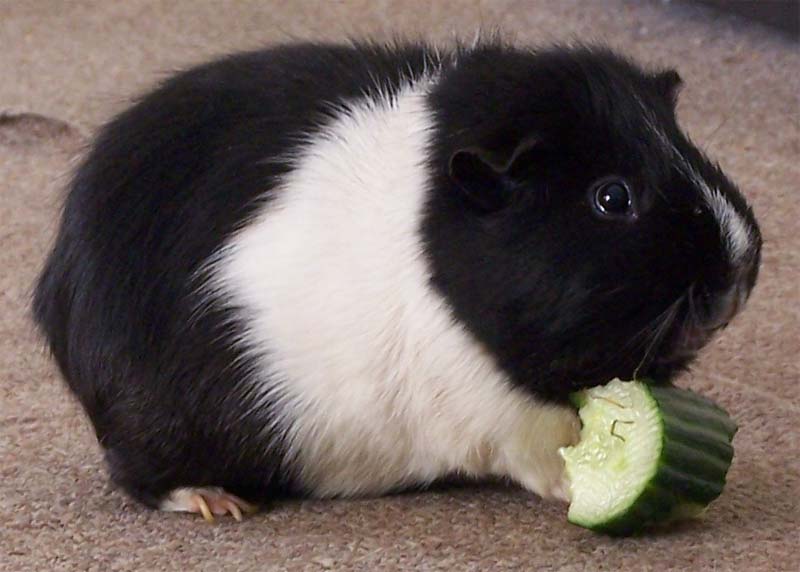How Much Pellets Should I Feed 2 Guinea Pigs
Guinea Pig Facts

Guinea pigs, also called cavies, are a domesticated species of rodent (Cavia porcellus). They were originally native to South America. However, they have been popular for thousands of years as pets and as food, and this species no longer exists in the wild.
The Incas domesticated Guinea pigs more than 3,000 years ago. They bred them as pets and for food and offered them as sacrifices to their gods, according to Sharon Lynn Vanderlip, author of "The Guinea Pig Handbook (opens in new tab)" (Barron's, 2003). Selective breeding resulted in variations in coat color, patterns and texture, as well as flavor subtleties, Vanderlip wrote. Around the end of the 16th century, Spanish conquistadors took Guinea pigs from South America to Europe, where they became popular pets among Elizabethan society, according the National Geographic (opens in new tab).
Not from Guinea & not a pig
No one is really sure where the name Guinea pig came from. According to Vanderlip, some historians speculate that the roasted meat reminded Europeans of suckling pigs. Some think Guinea pigs got their name from the squealing sounds they make. The name may come from the price of a Guinea pig in 16th-century England: 1 guinea. Some researchers say ships leaving the port of Guiana in South America or Guinea in West Africa may have carried the animals to the European market.
The little furry animals also have identity crises in other languages, Vanderlip wrote. In Germany, they have been calledmeerschweinchen (little sea pigs). In France, they arelapins de Barbarie(Barbary rabbits). And in Portugal, they are calledporchitas da India (little pigs from India). Cavies (pronounced kay-vees) can't seem to shake the pig connotation; even its species name,C. porcellus, means "little pig" in Latin.
Size & appearance
Guinea pigs are tailless rodents that weigh between 1.5 and 2.5 lbs. (700 to 1,100 grams), according to the Animal Diversity Web (ADW). Their compact, cylindrical bodies range from 8 to 10 inches (20.3 to 25.4 cm) long.
Their ears are small and petal-shaped and their eyes are set on the sides of their heads. They have small, triangular mouths, which contain 20 teeth. Like other rodents, their teeth grow continuously, and Guinea pigs must chew or gnaw constantly to keep them from growing too long.
According to ADW, there are 13 commonly recognized types or breeds of guinea pig: American, American satin, Abyssinian, Abyssinian satin, Peruvian, Peruvian satin, silkie, silkie satin, teddy, teddy satin, texel, coronet and the white crested. These breeds are characterized by differences in hair color, hair texture, the sheen of the pelage and the color patterns of the pelage.

Habitat
While domesticated Guinea pigs are no longer found in the wild, they do have some cousins, also called Guinea pigs, in South America that live in forests, savannas, mountainous grasslands and bushy areas. According to the International Union for Conservation of Nature (IUCN), the Brazilian Guinea pig is found in Brazil, Venezuela, Colombia, Ecuador, Guyana, Bolivia, northern Argentina, Uruguay and Paraguay. The Moleques do Sul Guinea pig is from Moleques Island do Sul, a 25-acre (10.5 hectares) island in Santa Catarina, Brazil. The shiny Guinea pig is found in coastal areas of southeastern Brazil. The greater Guinea pig occurs in southern Brazil and Uruguay. The Montane Guinea pig ranges from northwestern Argentina and northern Chile to Peru.
Habits
Guinea pigs are very social and are herd animals. They like to be with others of their own kind, but also thrive from human affection. They are crepuscular, which means they are most active during dusk and dawn. When they are awake, Guinea pigs spend their time feeding, grooming or investigating their cage, according to the ADW.
Diet
Guinea pigs are herbivores, meaning they do not eat meat. Typically, domesticated Guinea pigs eat processed pellets made from alfalfa hay or timothy hay and vitamins and minerals that Guinea pigs need to be healthy.
They also love vegetables and fruits such as kale, mustard greens, bell peppers, carrots, bananas, apples and blueberries. Unlike other small animals, Guinea pigs need Vitamin C to stay healthy, according to The Human Society of the United States.
Guinea pigs don't need to drink if they eat moist foods, according to Encyclopedia Britannica. Special water bottles that hang from the cage bars are often a good way to supplement water needs for pet Guinea pigs.

Offspring
Male cavies are called boars and females are called sows (again with the pig nomenclature). Baby Guinea pigs are called pups. Sows have a gestation period of 59 to 72 days and give birth to litters of three or four babies on average, although they can have as many as 13 babies at one time. Though pups nurse for nutrition, they can also eat solid food as soon as they are born.
At three weeks, the babies are weaned, and they are fully mature in two to three months. According to The Human Society of the United States, Guinea pigs live longer than many other small rodents. They typically live five to seven years.
Classification/taxonomy
The taxonomy of the Guinea pig, according to the Integrated Taxonomic Information System (ITIS), is:
- Kingdom: Animalia
- Subkingdom: Bilateria
- Infrakingdom: Deuterostomia
- Phylum: Chordata
- Subphylum: Vertebrata
- Infraphylum: Gnathostomata
- Superclass: Tetrapoda
- Class: Mammalia
- Subclass: Theria
- Infraclass: Eutheria
- Order: Rodentia
- Suborder: Hystricomorpha
- Infraorder: Hystricognathi
- Family: Caviidae
- Subfamily: Caviinae
- Genus:Cavia
- Species:Cavia aperea (Brazilian Guinea pig);Cavia fulgida (Shiny Guinea pig);Cavia intermedia (Moleques do Sul Guinea pig);Cavia magna (Greater Guinea pig);Cavia porcellus(domesticated Guinea pig);Cavia tschudii (Montane Guinea pig)
Conservation status
Domesticated Guinea pigs and most of their wild cousins are in no danger of extinction and are listed as "Least Concern" by the IUCN's Red List of Threatened Species. However, there were only 42 Moleques do Sul Guinea pigs left in the wild as of 2008, when the last assessment was made, and that species is listed as "Critically Endangered," the IUCN's highest threat level.
Guinea pigs as "guinea pigs"
According to Vanderlip, since the 1800s, Guinea pigs have been used in laboratories to study nutrition, genetic, toxicology and pathology. "Guinea pigs have done more than their fair share to contribute to medical science and to the health and well-being of humans and animals worldwide," she wrote.
According to ADW, Guinea pigs are used as subjects in biomedical research investigating scurvy, tuberculosis, juvenile diabetes, and pregnancy complications.
Additional resources
- National Center for Biotechnology Information: Comparison Between the Domestic Guinea Pig (Cavia aperea f. porcellus) and its Wild Ancestor, the Cavy (Cavia aperea)
- ASPCA: Care of Guinea Pigs
- Canadian Federation of Humane Societies: Guinea Pigs
madirazzaereun1996.blogspot.com
Source: https://www.livescience.com/50658-guinea-pig-facts.html